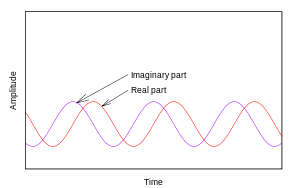Negative frequency
The concept of negative and positive frequency can be as simple as a wheel rotating one way or the other way: a signed value of frequency can indicate both the rate and direction of rotation. The rate is expressed in units such as revolutions (aka cycles) per second (hertz) or radian/second (where 1 cycle corresponds to 2π radians).
Sinusoids
Let ω be a nonnegative parameter with units of radians/sec. Then the angular function (angle vs. time) −ωt + θ, has slope −ω, which is called a negative frequency. But when the function is used as the argument of a cosine operator, the result is indistinguishable from cos(ωt − θ). Similarly, sin(−ωt + θ) is indistinguishable from sin(ωt − θ + π). Thus any sinusoids can be represented in terms of positive frequencies. The sign of the underlying phase slope is ambiguous.


The ambiguity is resolved when the cosine and sine operators can be observed simultaneously, because cos(ωt + θ) leads sin(ωt + θ) by 1/4 cycle (= π/2 radians) when ω > 0, and lags by 1/4 cycle when ω < 0. Similarly, a vector, (cos t, sin t), rotates counter-clockwise at 1 radian/sec, and completes a circle every 2π seconds, and the vector (cos -t, sin -t) rotates in the other direction.
The sign of ω is also preserved in the complex-valued function:
-
(Eq.1)
since R(t) and I(t) can be separately extracted and compared. Although clearly contains more information than either of its components, a common interpretation is that it is a simpler function, because:
- It simplifies many important trigonometric calculations, which leads to its formal description as the analytic representation of .[2]
- A corollary of Eq.1 is:
(Eq.2)
which gives rise to the interpretation that cos(ωt) comprises both positive and negative frequencies. But the sum is actually a cancellation that contains less, not more, information. Any measure that indicates both frequencies includes a false positive, because ω can have only one sign.[3] The Fourier transform, for instance, merely tells us that cos(ωt) correlates equally well with both cos(ωt) + i sin(ωt) and with cos(ωt) − i sin(ωt).
Applications
Perhaps the most well-known application of negative frequency is the calculation:
which is a measure of the amount of frequency ω in the function x(t) over the interval (a, b). When evaluated as a continuous function of ω for the theoretical interval (−∞, ∞), it is known as the Fourier transform of x(t). A brief explanation is that the product of two complex sinusoids is also a complex sinusoid whose frequency is the sum of the original frequencies. So when ω is positive, causes all the frequencies of x(t) to be reduced by amount ω. Whatever part of x(t) that was at frequency ω is changed to frequency zero, which is just a constant whose amplitude level is a measure of the strength of the original ω content. And whatever part of x(t) that was at frequency zero is changed to a sinusoid at frequency −ω. Similarly, all other frequencies are changed to non-zero values. As the interval (a, b) increases, the contribution of the constant term grows in proportion. But the contributions of the sinusoidal terms only oscillate around zero. So X(ω) improves as a relative measure of the amount of frequency ω in the function x(t).
The Fourier transform of produces a non-zero response only at frequency ω. The transform of has responses at both ω and −ω, as anticipated by Eq.2.
Sampling of positive and negative frequencies and aliasing

Notes
- ↑ The equivalence is called Euler's formula
- ↑ See Euler's formula § Relationship_to_trigonometry and Phasor § Addition for examples of calculations simplified by the complex representation.
- ↑ Conversely, any measure that indicates only one frequency has made an assumption, perhaps based on collateral information.
References
- Positive and Negative Frequencies
- Lyons, Richard G. (Nov 11, 2010). Chapt 8.4. Understanding Digital Signal Processing (3rd ed.). Prentice Hall. 944 pgs. ISBN 0137027419.